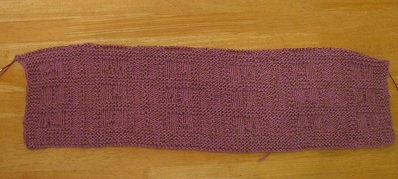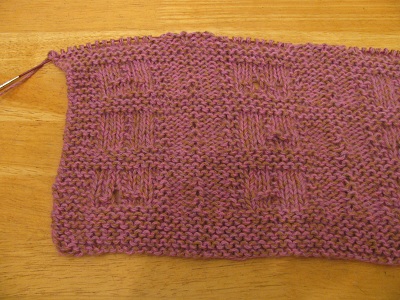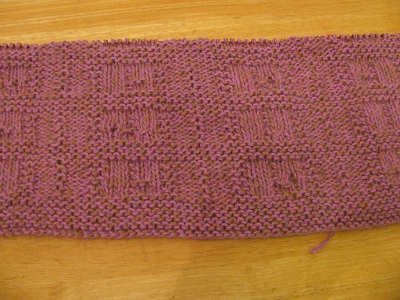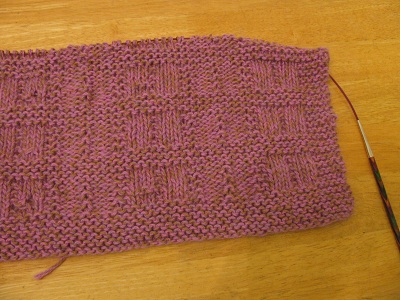I’m a math nut. I’ve always said that my prime factorization sweater proves it.
I finished knitting the sweater in 2005. It shows the color-coded prime factorization of all the whole numbers from 2 to 100. I’ve shown it to lots of people since then, with mixed amounts of appreciation. In 2009, I finally posted a blog explanation of it and how it works.
Last April, I wore it to the US Science and Engineering Festival. I showed it to Ivars Peterson, manning the Mathematical Association of America booth. He tweeted one tweet with a link to my blog post, and the next day I got 28,000 hits on my website.
And the post got so much attention, this month it’s appearing in Hacker News! In print! I’m happy that people are finding out about it. It’s just goes to show that Math is Beautiful.
Now, there’s no way I’m ever going to make a replica of the original sweater. It took way too long. But since then, I’ve designed a t-shirt for sale to all on Cafepress. I’ve knitted a scarf that uses color-coded stripes to represent the prime factorization of numbers up to 50. And I’ve begun work on a cuff-to-cuff cardigan that also uses color-coded stripes, similar to the scarf. I hope it will go up to 100.
But for now I’m taking a break from knitting the prime factorization cardigan, because my little sister is having a baby!
I wanted to knit something special for the little one, but not so blatantly mathematical. I decided to use a mathematical code to knit a blessing into the blanket.
Here’s how it works. I’m using the same pattern I used to knit my son a cotton blanket 18 years ago. It’s a simple knit-purl pattern. I didn’t want lace, since I wanted it to function as a warm blanket. I gave it to him whenever he ate and managed to get him very attached to it!
I want to knit a code into the blanket. The layout is a basic grid. It mimics a plaid, but with knits and purls. I decided to focus on the stockinette sections that show up on one side. These sections are seven stitches across, with the stitch in the middle purled on every other row. There are six sections across in the grid and a total of 20 sections vertically down the blanket.
The baby is a girl, and her middle name will probably be Karise, coming from the Greek word for grace. I decided to use the Christian blessing that shows up many times in the New Testament: “Grace and peace to you from God our Father and the Lord Jesus Christ.” After all, what more could you want for a baby than grace and peace?
That’s 14 words, so I decided to put one word on each row of the grid, with the words “Grace and Peace” before and after, using all 20 rows. Each word is six letters or less, so I can use the six stockinette sections to highlight the letters.
Now, how to do the letters? Simple! Years ago, I did a library program where I showed the kids that they could use the ideas from the sweater to make codes using colors or shapes for letters. You start with a simple 1 to 26 code for the letters A to Z. Then I will convert the numbers to base 5 and I only need 5 different coded digits.
Here’s how the letters will be represented:
A – 01 B – 02 C – 03 D – 04 E – 10
F – 11 G – 12 H – 13 I – 14 J – 20
K – 21 L – 22 M – 23 N – 24 O – 30
P – 31 Q – 32 R – 33 S – 34 T – 40
U – 41 V – 42 W – 43 X – 44 Y – 100
Z – 101
Then I assign certain stitches to represent each digit. Since knitting is done from right to left, I’m going to work the stitches on the purl side, so when I look at them, they will read left to right.
Here’s the code I’m using, with two stitches for each digit.
0 = purl 2 (p2)
1 = knit 2 (k2)
2 = yarn over, knit 2 together (ykt)
3 = ssk, yarn over (sky)
4 = cable one purl stitch in back (cb)
Since the purl sections I’m using have 3 purl stitches, one knit stitch and then 3 purl stitches, I’m putting in the code this way: one purl stitch, then the first digit of the coded letter,
then one knit stitch, then the second digit of the coded letter, then one purl stitch.
I’m doing this on the middle row of the section of the grid.
I am working the code from the bottom of the blanket, so I had to list all the words in backwards order.
Here’s how it’s working out!
This picture shows the bottom three rows of the large grid. So I encoded the words “Grace and Peace.” Here’s the detail:
Looking at the first two sections of each word, on the top row, we have G = 12 = k2, ykt; R = 33 = sky, sky.
Second row has a blank section to center “AND,” then A = 01 = p2, k2.
Third row has P = 31 = sky, k2; E = 10 = k2, p2.
Here’s the middle section:
For the middle, on the top row, we have A = 01 = p2, k2; C = 03 = p2, sky.
Second row has N = 24 = ykt, cb; D = 04 = p2, cb
Third row has A = 01 = p2, k2; C = 03 = p2, sky
And finally, the last two sections in the row:
This just has the end of each word. On the first and third row, that’s E = 10 = k2, p2. We’ve got “blank” sections in the other slots.
Oh, and I should mention that on yarn.com, I purchased some fabulously soft yarn on sale. It’s Artful Yarns Serenade, and it’s 70% pima cotton, and 30% angora. There’s one strand of pink, one of purple, and one of brown, which I thought more interesting than straight pink. It’s ending up so beautiful and wonderful to touch. I always say that knitting with soft yarn is like therapy. And this time, I get to knit in a mathematical blessing.
My posts on Mathematical Knitting and related topics are now gathered at Sonderknitting.



